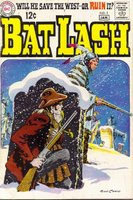The differential in comic capacity had significant impacts. For example, my hometown of Allendale had a small newsstand with only one spinner rack, which meant that the only comics stocked were DC, Archie or Harvey; it was not until about 1968 that I can recall seeing a Marvel there and that was a stray Silver Surfer issue. The town north of mine had a bigger newsstand (which was also closer to the train station), so they had Marvels and Charltons as well.
Comics were sent to stores with the understanding that unsold copies could be returned to the comics company for a refund. To save money on mailing costs, comics companies had the vendors simply tear off the top 1/3rd of the cover and send that back; they were then supposed to destroy the rest of the comic although it was not uncommon for vendors to turn around and sell those partial cover issues to used bookstores. Hence the fact that all comics dedicated about the top 1/3rd of the cover to the title of the comic, and this exhortation that I'm sure all of you have ignored thousands of times (as have I):

Hence also the numerous older comics that come up for sale on ebay with that crucial top-third of the cover missing. By the way, almost all magazines were sold that way, not just comic books; when I worked at a convenience store in the early 1970s one of my weekly tasks was to pull the TV Guides and rip off that same top third.
How did the comics companies know they had a hit on their hands? It's really pretty simple; on those issues the number of returns were smaller. As a practical matter, I'm sure each of the editors had a few high-volume locations (like Grand Central Station) he could call to check on how many copies were remaining of a particular issue to gauge interest a little quicker.
What were typical returns like? I don't know yet, but I am going to look into the matter. Starting with 1965's reporting year DC began reporting more detailed information on their publications than had previously been available. Here's the Batman report as it appeared in Batman #183:

DC's returns for Batman were about 35% on average with the most recent issue about 30%.
Here's the statement from Challengers of the Unknown #51:

Returns for Challengers were generally around 35%.
World's Finest #158:

Again, returns running generally in the 30-35% range.
This appears to have been intentional. The comics companies back then always made sure that there were excess copies printed, partly on the theory that if something was a hit they could tell (because suddenly returns went down), and partly because if the issue turned out to sell higher than normal, they could then charge their advertisers more. Remember, the money that the comics companies made from sales of the comics was (relatively) peanuts compared to the big money in the books, which came from the ads.
Of course, none of this has anything to do with the way comics are sold now, with the publishers shipping pre-ordered comics to (mostly) comics-only stores which cannot return them. But I thought I would mention it because it's definitely one of the major differences between comics of the Silver Age and comics today.





